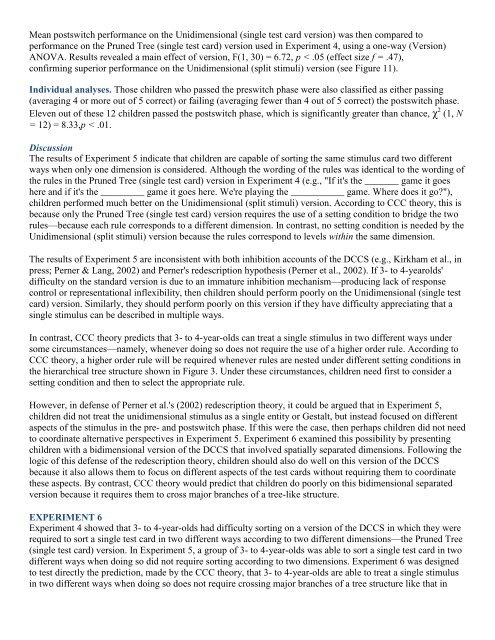THE DEVELOPMENT OF EXECUTIVE FUNCTION IN EARLY ...
THE DEVELOPMENT OF EXECUTIVE FUNCTION IN EARLY ...
THE DEVELOPMENT OF EXECUTIVE FUNCTION IN EARLY ...
You also want an ePaper? Increase the reach of your titles
YUMPU automatically turns print PDFs into web optimized ePapers that Google loves.
Mean postswitch performance on the Unidimensional (single test card version) was then compared to<br />
performance on the Pruned Tree (single test card) version used in Experiment 4, using a one-way (Version)<br />
ANOVA. Results revealed a main effect of version, F(1, 30) = 6.72, p < .05 (effect size f = .47),<br />
confirming superior performance on the Unidimensional (split stimuli) version (see Figure 11).<br />
Individual analyses. Those children who passed the preswitch phase were also classified as either passing<br />
(averaging 4 or more out of 5 correct) or failing (averaging fewer than 4 out of 5 correct) the postswitch phase.<br />
Eleven out of these 12 children passed the postswitch phase, which is significantly greater than chance, χ 2 (1, N<br />
= 12) = 8.33,p < .01.<br />
Discussion<br />
The results of Experiment 5 indicate that children are capable of sorting the same stimulus card two different<br />
ways when only one dimension is considered. Although the wording of the rules was identical to the wording of<br />
the rules in the Pruned Tree (single test card) version in Experiment 4 (e.g., "If it's the _______ game it goes<br />
here and if it's the _________ game it goes here. We're playing the ___________ game. Where does it go?"),<br />
children performed much better on the Unidimensional (split stimuli) version. According to CCC theory, this is<br />
because only the Pruned Tree (single test card) version requires the use of a setting condition to bridge the two<br />
rules—because each rule corresponds to a different dimension. In contrast, no setting condition is needed by the<br />
Unidimensional (split stimuli) version because the rules correspond to levels within the same dimension.<br />
The results of Experiment 5 are inconsistent with both inhibition accounts of the DCCS (e.g., Kirkham et al., in<br />
press; Perner & Lang, 2002) and Perner's redescription hypothesis (Perner et al., 2002). If 3- to 4-yearolds'<br />
difficulty on the standard version is due to an immature inhibition mechanism—producing lack of response<br />
control or representational inflexibility, then children should perform poorly on the Unidimensional (single test<br />
card) version. Similarly, they should perform poorly on this version if they have difficulty appreciating that a<br />
single stimulus can be described in multiple ways.<br />
In contrast, CCC theory predicts that 3- to 4-year-olds can treat a single stimulus in two different ways under<br />
some circumstances—namely, whenever doing so does not require the use of a higher order rule. According to<br />
CCC theory, a higher order rule will be required whenever rules are nested under different setting conditions in<br />
the hierarchical tree structure shown in Figure 3. Under these circumstances, children need first to consider a<br />
setting condition and then to select the appropriate rule.<br />
However, in defense of Perner et al.'s (2002) redescription theory, it could be argued that in Experiment 5,<br />
children did not treat the unidimensional stimulus as a single entity or Gestalt, but instead focused on different<br />
aspects of the stimulus in the pre- and postswitch phase. If this were the case, then perhaps children did not need<br />
to coordinate alternative perspectives in Experiment 5. Experiment 6 examined this possibility by presenting<br />
children with a bidimensional version of the DCCS that involved spatially separated dimensions. Following the<br />
logic of this defense of the redescription theory, children should also do well on this version of the DCCS<br />
because it also allows them to focus on different aspects of the test cards without requiring them to coordinate<br />
these aspects. By contrast, CCC theory would predict that children do poorly on this bidimensional separated<br />
version because it requires them to cross major branches of a tree-like structure.<br />
EXPERIMENT 6<br />
Experiment 4 showed that 3- to 4-year-olds had difficulty sorting on a version of the DCCS in which they were<br />
required to sort a single test card in two different ways according to two different dimensions—the Pruned Tree<br />
(single test card) version. In Experiment 5, a group of 3- to 4-year-olds was able to sort a single test card in two<br />
different ways when doing so did not require sorting according to two dimensions. Experiment 6 was designed<br />
to test directly the prediction, made by the CCC theory, that 3- to 4-year-olds are able to treat a single stimulus<br />
in two different ways when doing so does not require crossing major branches of a tree structure like that in
















